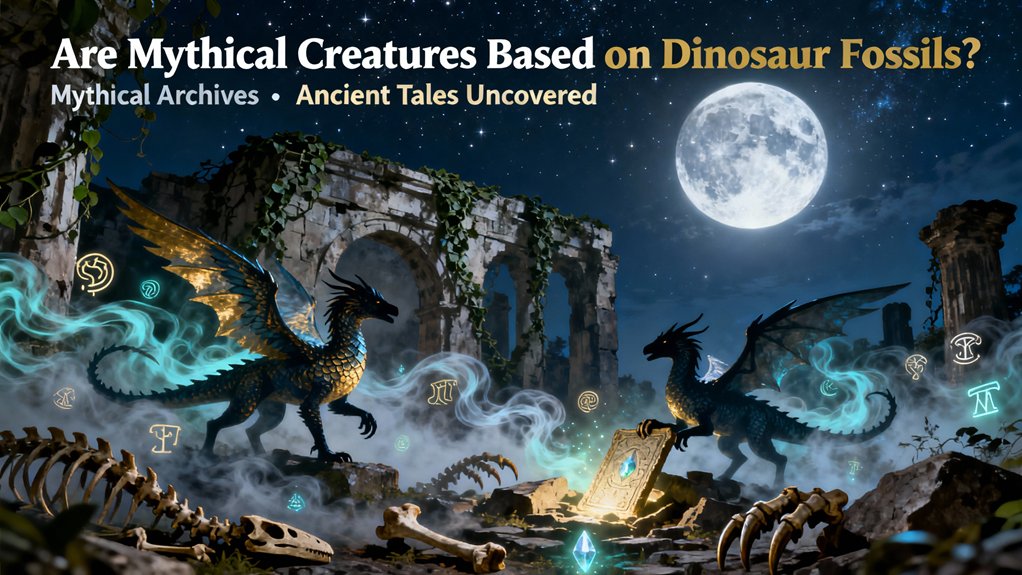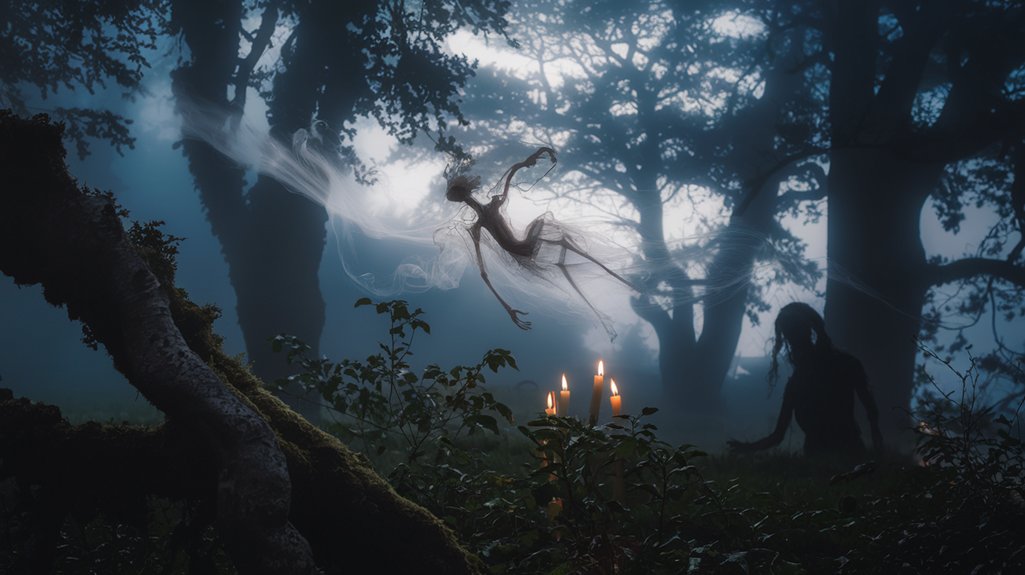You'll find compelling evidence that ancient peoples altered fossil discoveries into mythological frameworks—Chinese scholars documented theropod remains as lóng gǔ (dragon bones), Scythian miners interpreted Protoceratops skulls with their chimeric beaks as griffin guardians, and Mediterranean cultures mistook mammoth crania's nasal cavities for cyclops eye sockets. These weren't mere superstitions but sophisticated attempts to reconcile empirical observations with cosmological understanding, weaving skeletal leviathans into sacred narratives that honored both mystery and tangible evidence. The connections between paleontological remains and legendary creatures reveal deeper patterns worth exploring further.
🔮 Enhance Your Practice With These Essentials
Chosen for ritual alignment and energetic correspondence.
🔮 Enhance Your Practice With These Essentials
Chosen for ritual alignment and energetic correspondence.
🎯 Recommended Products
Handpicked items related to this article:
As an Amazon Associate, we earn from qualifying purchases.
Key Takeaways
- Ancient peoples discovered fossils and interpreted them through their cosmological frameworks, creating myths about dragons, griffins, giants, and cyclopes.
- Chinese dragon legends correspond with theropod fossils, with dragon bone documentation spanning over two millennia for medicinal and scholarly purposes.
- Griffin myths likely originated from Protoceratops fossils discovered by Scythian miners, with beaked skulls and frills matching mythological descriptions.
- Mammoth skulls inspired cyclops legends, as nasal cavities resembled single eye sockets and proportions matched biblical giant descriptions.
- Modern paleontologists trace mythological creatures to specific fossils, confirming ancient cultures practiced sophisticated proto-paleontology through empirical observation.
The Discovery of Fossils in Ancient Times
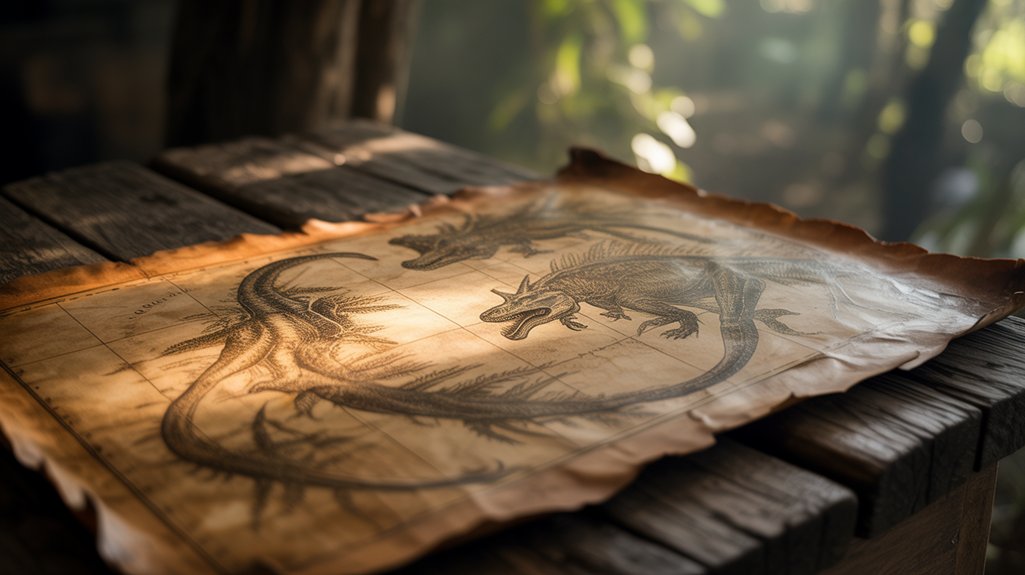
When ancient peoples first encountered the massive skeletal remains embedded in cliffsides and riverbanks, they possessed no framework for paleontology, no concept of deep time stretching back millions of years—yet they didn't dismiss these enigmatic bones as mere curiosities.
Ancient peoples lacked our scientific lens for fossils—yet they recognized these bones demanded explanation, not dismissal.
You'll find that ancient civilizations wove these discoveries into their cosmologies with remarkable sophistication. The Greeks interpreted enormous femurs as evidence of Titans. Chinese scholars documented “dragon bones” centuries before Western paleontology emerged, recognizing their fossil significance while integrating them into pharmacological traditions. Indigenous Australian peoples encoded megafauna remains into Dreamtime narratives, preserving ecological memory across millennia.
These weren't primitive misunderstandings. They were interpretive frameworks—attempts to reconcile the eldritch with the tangible, to explain chimeric forms that defied known biology.
When you examine Protoceratops skulls from the Gobi Desert, you're witnessing potential origins of griffin mythology. The bones spoke. Ancient peoples listened, creating meaning from mystery.
Dragon Legends and Dinosaur Bones in China
Throughout the river valleys of the Yellow and Yangtze, where sedimentary deposits yielded prodigious ossified remains, Chinese scholars developed what may constitute history's longest continuous engagement with vertebrate fossils—a tradition spanning over two millennia before Owen coined “Dinosauria” in 1842.
You'll discover that dragon origins intertwine inextricably with paleontological evidence, as ancient texts document systematic collection of lóng gǔ—dragon bones—for medicinal and scholarly purposes.
Consider these pivotal connections between fossil interpretations and chimeric iconography:
- Physical Evidence: Fossilized vertebrae and skulls, ground into elixirs, appeared in pharmacological records from the Western Han Dynasty (206 BCE–9 CE)
- Anatomical Correspondence: Multi-tonal scales, serpentine spines, and predatory jaws mirror theropod morphology discovered centuries later
- Geographic Correlation: Dragon sighting accounts cluster precisely where Cretaceous formations surface
These weren't mere superstitions. Ancient naturalists engaged in proto-paleontology, interpreting tangible remains through cosmological frameworks.
The eldritch magnificence you recognize in classical dragon imagery reflects genuine empirical observation.
Griffins and Protoceratops Fossils in Central Asia
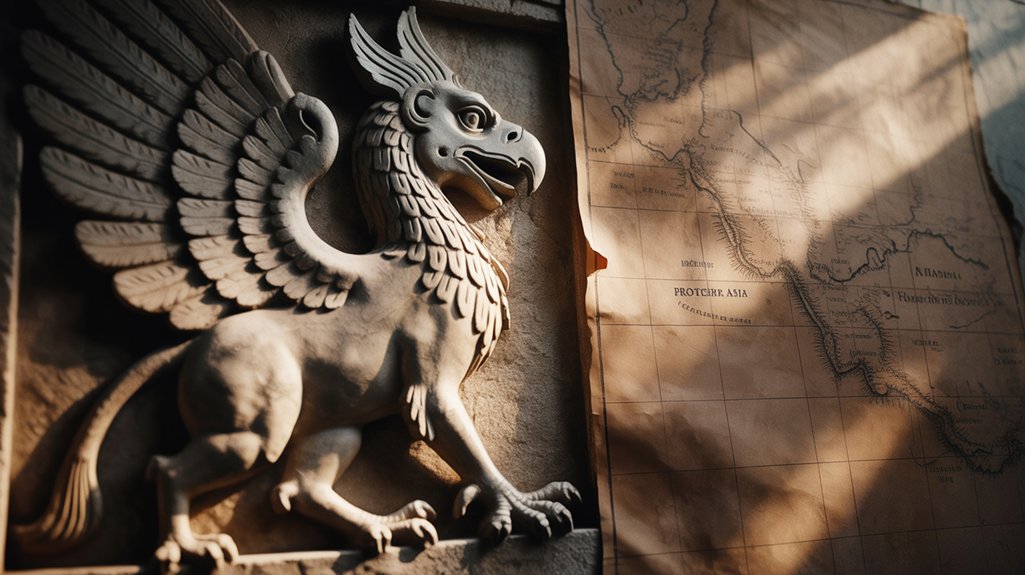
You encounter the griffin myth across the windswept steppes of Central Asia, where Scythian nomads spun tales of beaked, gold-hoarding creatures dwelling in remote mountain passes—stories that may have emerged from their discovery of *Protoceratops* remains weathering from Gobi Desert sandstone.
The chimeric beast's distinctive parrot-like beak, prominent frill, and quadrupedal stance correspond uncannily to the fossilized skulls these ancient miners would have unearthed while searching for precious metals in precisely those regions where Late Cretaceous deposits surface.
Consider that these encounters with eldritch bones occurred not in scholarly museums but in liminal desert spaces, where fragmented skeletons emerged from eroding cliffs like oracular messages from an incomprehensible past.
Protoceratops Skull Features
The beak-like rostrum of Protoceratops andrewsi, jutting forward from a skull that measures roughly twenty inches in length, presents an unmistakable avian quality—a feature that would have appeared profoundly chimeric to ancient Scythian gold miners traversing the Gobi Desert's wind-scoured badlands.
This ceratopsian's cranial architecture speaks volumes about protoceratops behavior and survival within its protoceratops habitat, where sandy expanses demanded specialized feeding adaptations.
Consider these eldritch characteristics that mirror griffin mythology:
- The pronounced frill, extending backward like predatory wings folded in eternal rest
- Four-limbed posture, suggesting quadrupedal power unconstrained by natural taxonomy
- Eye socket positioning, creating a raptor's penetrating gaze across millennia
Ancient prospectors, discovering these ossified remnants weathering from Cretaceous sediments, encountered evidence defying their cosmological frameworks—beasts transcending boundaries between earth-bound and sky-borne entities.
Ancient Gold Mining Legends
When Scythian miners descended into the auriferous ravines of the Altai Mountains circa 700 BCE, their extraction efforts unearthed more than gold-bearing quartz—they discovered massive skeletal remains embedded within the same strata that promised wealth.
These ancient mining operations, documented in Herodotus's *Histories*, describe griffins as fierce guardians of subterranean treasure. The eldritch beaked skulls emerging from goldfields weren't chimeric fantasies—they were Protoceratops remains.
You'll find that gold legends throughout Central Asia consistently intertwine precious metals with monstrous sentinels. The fossils' distinctive frills and raptor-like beaks created compelling narratives that protected mining territories, altering paleontological discoveries into apotropaic myths.
Here, where commerce met the uncanny, freedom-seeking prospectors wove their fears and findings into protective lore that transcended mere superstition.
Giant Mythology and Mammoth Remains
Across frozen steppes and windswept tundras where mammoth bones erupted from eroding permafrost, ancient peoples encountered skeletal titans that defied comprehension—femurs thick as tree trunks, skulls broad as ceremonial shields, curved tusks spanning twice a human's height.
These giant mammoths, preserved in ice for millennia, became corporeal evidence for ancient giants that stalked creation's dawn.
You'll find three convergent patterns linking megafaunal remains to cyclops and nephilim traditions:
- Proboscidean skull morphology—the central nasal cavity misinterpreted as a singular orbital socket, birthing one-eyed behemoths
- Stratigraphic displacement—floods and earthquakes exposing bones that validated deluge narratives and antediluvian races
- Dimensional correspondence—mammoth proportions matching textual descriptions of Og, Goliath, and other scriptural colossi
These discoveries weren't misunderstandings but rational attempts at paleontological interpretation.
Indigenous cosmologies absorbed empirical evidence, weaving eldritch findings into heritage systems that honored both mystery and observable truth.
Sea Serpents and Marine Reptile Discoveries
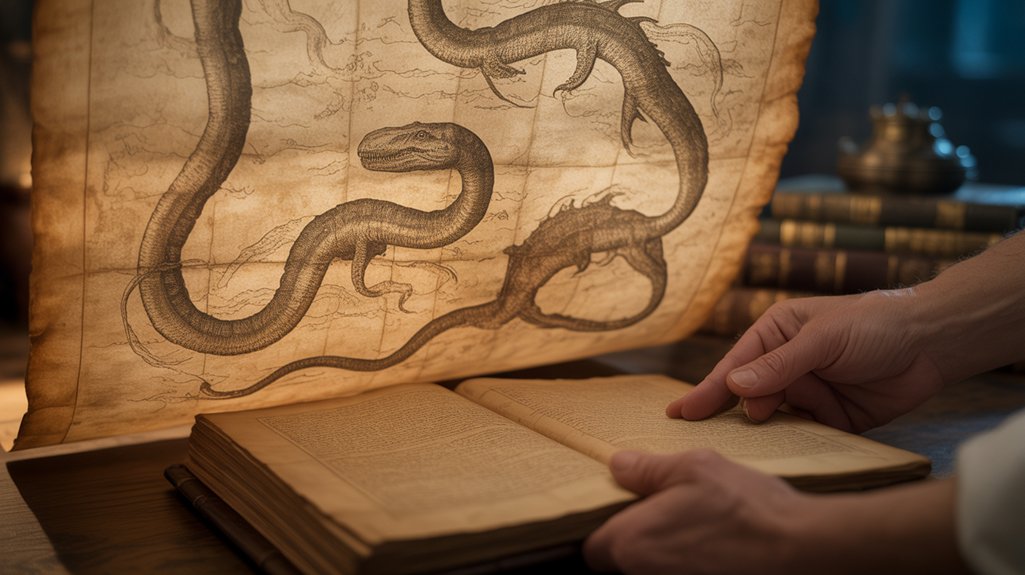
You stand at the threshold where serpent legends, coiled through millennia of maritime folklore from Norse *jörmungandr* to Japanese *ryū*, converge with paleontological discoveries of plesiosaurs—those eldritch marine reptiles whose elongated necks and massive bodies haunted Mesozoic seas between 205 and 66 million years ago.
The uncanny resemblance persists: fishermen's accounts of undulating forms breaking ocean surfaces mirror the anatomical reality of *Elasmosaurus*, its forty-foot vertebral column swaying through Cretaceous waters with serpentine fluidity.
These convergences suggest that ancient coastal communities, unearthing fossilized remains embedded in cliff faces and tidal zones, wove their discoveries into living mythologies—transforming bone into archetype, extinction into eternal return.
Ancient Plesiosaur Fossil Connections
The serpentine forms carved into Viking longships and the coiling dragons of Chinese maritime lore find their corporeal echoes in the fossilized remains of plesiosaurs—those eldritch marine reptiles whose elongated necks and diamond-shaped bodies haunted Earth's oceans throughout the Mesozoic Era, from approximately 203 to 66 million years ago.
You'll discover how ancient mariners, confronting these bleached skeletons upon storm-wracked shores, altered scientific reality into plesiosaur myths that transcended cultural boundaries.
Consider these tangible connections:
- Neck vertebrae clusters measuring fifteen feet in length, easily mistaken for segmented serpents
- Paddle-fin impressions in limestone, suggesting chimeric creatures neither fish nor beast
- Skull morphology displaying pronounced fangs, validating accounts of sea monsters
These prehistoric remnants didn't merely inspire legends—they validated humanity's intuitive understanding that something ancient and terrible once ruled the depths.
Serpent Legends Across Cultures
When Norwegian sailors reported enormous writhing forms breaching the North Atlantic swells in 1734, when Japanese fishermen carved namazu into shrine walls to appease the earthquake-bringer, when Mesopotamian scribes pressed cuneiform accounts of Tiamat into clay tablets circa 2000 BCE—these weren't mere fabrications born of maritime superstition or preliterate fear. You're witnessing serpent symbolism emerging wherever fossilized marine reptiles weathered from coastal cliffs.
| Culture | Serpent Entity | Fossil Connection |
|---|---|---|
| Norse | Jörmungandr | Mosasaur vertebrae |
| Chinese | Jiaolong | Plesiosaur remains |
| Māori | Taniwha | Ichthyosaur skulls |
Cultural comparisons reveal identical anatomical descriptions: elongated bodies, paddle-like appendages, predatory jaws. These eldritch leviathans transcend geographical boundaries. Ancient peoples possessed observational freedom modern science often dismisses—recognizing chimeric truths embedded in stone, altering calcium and fossilized bone into cosmological frameworks that honored nature's terrible majesty.
Cultural Interpretations of Unexplained Bones
Long before modern paleontology emerged as a formal discipline in the 1820s, ancient peoples across disparate continents encountered massive skeletal remains protruding from eroded cliffsides and riverbeds—bones that defied explanation within their cosmological frameworks.
You'll find these discoveries weren't dismissed as anomalies. Instead, they shaped the cultural significance of entire belief systems, altering unexplained femurs and vertebrae into evidence of eldritch giants, dragons, and chimeric beasts that once walked the earth.
Three distinct interpretations emerged:
- Greco-Roman scholars attributed mammoth skulls to cyclopes, their single nasal cavities mistaken for eye sockets.
- Chinese dynasties venerated “dragon bones” as medicinal treasures, grinding Jurassic fossils into remedies.
- Native American traditions wove massive bones into creation narratives, honoring them as ancestors.
These ancient beliefs weren't primitive misunderstandings—they represented sophisticated attempts to reconcile physical evidence with existing worldviews, each culture crafting mythologies that honored the numinous power of these prehistoric remnants.
Modern Evidence Linking Fossils to Monster Tales
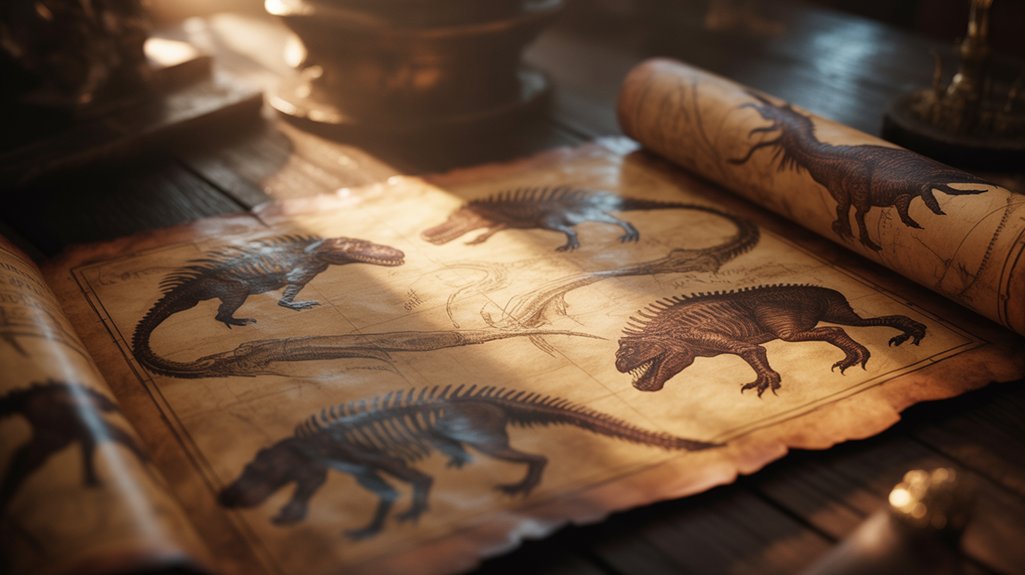
Contemporary paleontologists haven't simply inherited these ancient interpretations—they've systematically traced specific mythological creatures back to their fossil origins, constructing an ethnographic map where legend and limestone intersect.
You'll find remarkable fossil interpretations emerging from this scholarship: the Protoceratops skulls of Mongolia's Gobi Desert align precisely with Griffin iconography, their beaked crania suggesting avian-reptilian hybrids. The creature comparisons grow more compelling.
Mammoth remains in Siberian permafrost explain the chimeric proportions of regional ogres. You witness how Megalosaurus femurs, unearthed in seventeenth-century England, fed dragon narratives that persisted until Richard Owen's 1842 taxonomic revolution.
Consider the Cyclops mythology—now understood through dwarf elephant skulls whose central nasal cavities mimicked singular eye sockets.
These fossil interpretations aren't dismissive reductions of sacred stories. Rather, they illuminate humanity's ancient capacity for empirical observation, altering eldritch remains into cosmological frameworks that honored both physical evidence and numinous mystery.
Frequently Asked Questions
Could Ancient Civilizations Have Accurately Reconstructed Entire Dinosaurs From Partial Fossils?
You'll find ancient anatomy knowledge insufficient for accurate reconstruction. Without modern comparative osteology, your ancestors lacked frameworks for fossil interpretation beyond their lived experience—mammalian, reptilian, avian forms they knew intimately.
Those fragmented bones, glimpsed in cliff faces and eroding riverbeds, sparked chimeric visions instead: dragons, griffins, cyclopes. The eldritch remains whispered possibilities, not certainties.
Complete skeletal articulation requires techniques developed only in the nineteenth century, freedoms of scientific method your predecessors couldn't access, however brilliant their observational skills.
Why Did Some Cultures Not Develop Mythical Creatures Despite Finding Fossils?
Consider medieval Iceland, where Norse settlers documented abundant whale bones yet crafted no chimeric beasts from them.
You'll find that cultural perception determines whether fossils become mythological fodder—societies grounded in empirical observation, like certain Scandinavian communities, interpreted remains through practical frameworks rather than eldritch imagination.
Your fossil interpretation depends on existing cosmological structures; cultures lacking creation myths involving monstrous primordial beings simply catalogued skeletal discoveries as unknown animals, refusing to weave mystical narratives where rational explanation sufficed.
Are Any Modern Cryptids Potentially Based on Recently Extinct Animal Remains?
You'll discover compelling cryptid origins in recently vanished fauna.
The Mokele-mbembe legends, emerging post-1900s, may echo sauropod remains weathering from Congo's primordial sediments.
Tasmania's thylacine—extinct 1936—still haunts Aboriginal Dreamtime narratives, its striped flesh transmuted into eldritch guardian-forms.
Madagascar's elephant bird bones, discovered by colonial expeditions through the 1800s, likely spawned the Vorombe titan myths.
These extinct species, their skeletal geometries recently unearthed, become chimeric vessels for humanity's eternal dance with the unknown, the numinous.
Did Ancient Fossil Discoveries Influence Religious Beliefs and Creation Stories?
Though you might dismiss this as speculation, fossil interpretations undeniably shaped ancient mythology and cosmologies.
You'll find fourth-century BCE Greek scholars documenting Protoceratops remains in Scythian goldfields, birthing griffin legends.
Ancient Chinese apothecaries, harboring “dragon bones” since 300 BCE, wove dinosaur fossils into celestial hierarchies.
You're witnessing humanity's eldritch attempts to comprehend chimeric bones—sacred relics that challenged creation narratives, forced theological adaptations.
These discoveries weren't mere curiosities; they fundamentally restructured how civilizations conceived their origins, their gods.
How Did Isolated Island Cultures Explain Fossilized Remains Without Mainland Influence?
You'll discover island cultures developed autonomous fossil myths through direct environmental encounters.
Pacific Polynesian navigators wove megafauna bones into island legends of primordial titans, while Malagasy peoples interpreted elephant bird remains as ancestral spirits dwelling between worlds.
These isolated communities generated chimeric interpretations independently—no mainland contamination required.
Their eldritch narratives emerged from limestone caves, storm-washed beaches, volcanic ash beds.
Each culture altered fossilized evidence into sacred cosmology, proving humanity's universal need to mythologize the ancient, the mysterious, the liberating unknown.
Conclusion
You've journeyed through the liminal spaces where bone becomes legend, where ancient peoples gazed upon eldritch remains and wove them into cultural tapestry. These chimeric tales—dragons, griffins, leviathans—aren't mere fantasy. They're humanity's reverent attempt to comprehend the incomprehensible, to name the unnamed. The fossils whispered secrets across millennia. Your ancestors listened, converting calcium into mythology, death into resurrection. Science now illuminates what mystery once shrouded, yet wonder persists, eternal.
